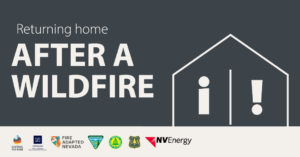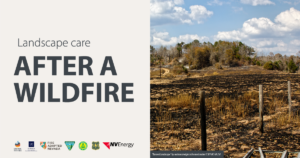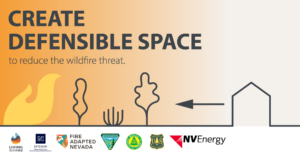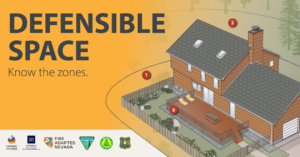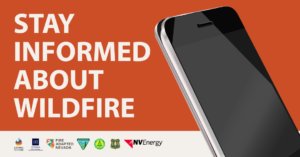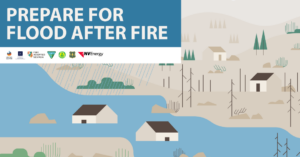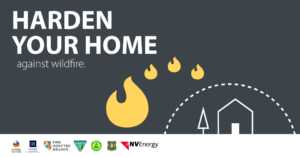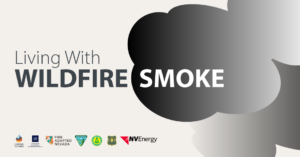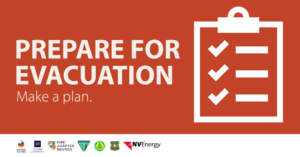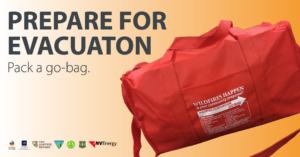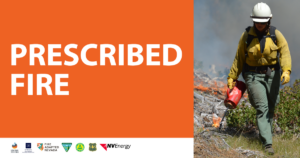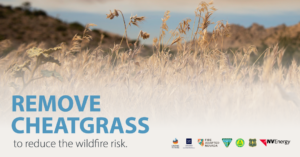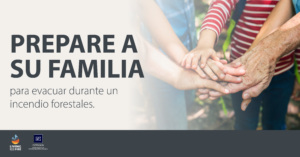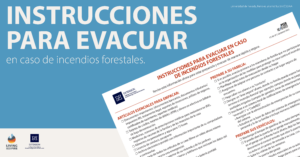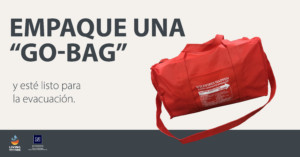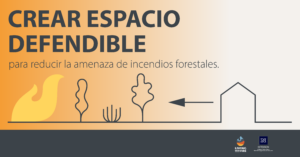Living With Fire Social Media Toolkit
How to Use the Toolkit:
The Living With Fire Social Media Toolkit contains wildfire preparedness messages on various topics you can share on your social media channels. Feel free to copy these messages directly or customize them for your audience. Topics include evacuation preparedness, defensible space, home hardening, living with smoke, prescribed fire, after fire recovery and preparing for flood after fire. We’ve also created some graphics you can download and share, along with the key messages below.
Key Messages | English
Preparing for Evacuation:
- Wildfire evacuations are stressful events, and residents often don’t have much notice before leaving their homes. So prepare now for evacuation. Learn how at https://www.livingwithfire.com/get-prepared/make-an-evacuation-plan/
- A go-bag can help you quickly and safely evacuate during a wildfire. Learn how to put one together at https://www.livingwithfire.com/get-prepared/make-an-evacuation-plan/make-a-go-bag-and-disaster-supplies-kit/
- Know your neighborhood! Plan an escape route for when wildfire hits your community. Make sure to plan a secondary route in case the primary route is blocked. Learn more about preparing for evacuation at https://www.livingwithfire.com/get-prepared/make-an-evacuation-plan/
- When evacuating from a wildfire, you only have time to bring the essentials, leaving your valued possessions behind. While nothing can replace these possessions, a regularly updated home inventory can ensure you are reimbursed for damaged and destroyed property. Learn how to create a home inventory at https://www.iii.org/article/how-create-home-inventory
- Many people living in high fire hazard areas have pets and livestock. Prepare to evacuate your animals before wildfire happens. Pack a go-bag with everything your animals might need and make sure that you can safely transport them. Learn more at https://www.livingwithfire.com/get-prepared/make-an-evacuation-plan/prepare-my-home-and-family-for-evacuation/preparing-pets-and-livestock-for-evacuation/
- When preparing for wildfire, think about people in your community with disabilities and their access to functional needs. Learn more at https://www.livingwithfire.com/get-prepared/make-an-evacuation-plan/prepare-my-home-and-family-for-evacuation/
- Local Emergency alert systems, like the CodeRED system, deliver emergency messages to individuals located in affected regions, such as specific neighborhoods or communities. Sign up for emergency notifications in your county at https://www.livingwithfire.com/get-prepared/make-an-evacuation-plan/sign-up-for-emergency-notifications/
Defensible Space:
- Creating Defensible Space can reduce the wildfire threat, allow firefighters to safely defend the house, and can improve the likelihood of a home surviving without assistance from firefighters Learn how to create effective defensible space at https://www.livingwithfire.com/get-prepared/how-to-improve-my-defensible-space/
- Flammable vegetation close to homes poses a significant wildfire threat. Creating and maintaining defensible space can reduce that threat. Learn how to create effective defensible space at https://www.livingwithfire.com/get-prepared/how-to-improve-my-defensible-space/
- The zone within 5 feet of your home has many different names (e.g., the noncombustible zone, the immediate zone, the zero zone), but the objective is generally the same—to reduce the vulnerability of the home to embers by creating a zone of ember-resistant materials around the home. Learn more at https://www.livingwithfire.com/get-prepared/how-to-improve-my-defensible-space/
- Firefighters often refer to ornamental junipers as “little green gas cans”. They contain flammable resins and dried vegetation, and when ignited can burn intensely. Keep these “little green gas cans” at least 30 feet from the house or replace them with low-growing deciduous shrubs, herbaceous flowers, rock mulches and hard surfaces.
- Dense groups of trees and shrubs pose a significant wildfire threat. Thinning dense plant life to create more space between them can increase the effectiveness of defensible space. Learn how to create effective defensible space at https://www.livingwithfire.com/get-prepared/how-to-improve-my-defensible-space/
- If you live in a high fire hazard area, you have the power to improve the odds of your home surviving a wildfire. One key thing that individuals can do is choose the right plants in their landscape. Learn how at https://bit.ly/3G8C9b4
- To reduce the risk of wildfire, remove all dead vegetation near buildings, houses and structures. Learn more about preparing your property for wildfire at https://www.livingwithfire.com/get-prepared/how-to-improve-my-defensible-space/
- Dry cheatgrass is probably the most easily ignitable vegetation on Nevada’s rangelands. Learn how to manage cheatgrass to reduce the wildfire risk at https://extension.unr.edu/publication.aspx?PubID=2364
Home Hardening:
- “Home Hardening” is a term that refers to the practice of retrofitting components of a home to reduce vulnerability to wildfire. Learn more at https://www.livingwithfire.com/get-prepared/how-to-make-my-home-fire-safe/
- Research Suggests that 60-90% of homes lost during wildfires are ignited by burning embers. Hardening your home will reduce your home’s vulnerability to embers and decrease the chance of ignition. Learn more at https://www.livingwithfire.com/get-prepared/how-to-make-my-home-fire-safe/
- Reducing the vulnerability of homes to ember ignition will increase the chance of homes and neighborhoods surviving a wildfire. Learn more at https://www.livingwithfire.com/get-prepared/how-to-make-my-home-fire-safe/
- This Wildfire Home Retrofit Guide includes specific recommendations for retrofitting existing components of a home to withstand wildfire. Each section contains an explanation of how the component is vulnerable to wildfire and what can be done to improve that component. View the guide at https://naes.agnt.unr.edu/pms/pubs/2020-3810.pdf
- The most effective way for homes to withstand wildfire is a “coupled approach” that considers the home’s exterior construction materials and how they are put together, as well as the surrounding vegetation and other near-home combustible materials.
Living With Smoke:
- Wildfire smoke contains microscopic, fine particulate matter that can enter your eyes or be inhaled deep into your respiratory system, causing serious symptoms and potentially worsening chronic lung or heart conditions. Learn how to live more safely with wildfire smoke at https://www.livingwithfire.com/get-prepared/living-with-smoke/
- During a wildfire, smoke affects air quality. Before going out, make sure to check the air quality often. Consult airnow.gov for real-time air quality updates.
- Reduce your exposure to smoke and create a “clean room” in your home. Choose a room with no fireplace and with few windows and doors. Use a portable air cleaner or purifier in the room. Learn more at https://www.livingwithfire.com/get-prepared/living-with-smoke/
- Wildfire smoke is bad for your health. Using the right air filter in your home can help improve your indoor air quality during a wildfire. Learn more at https://www.livingwithfire.com/get-prepared/living-with-smoke/
- Strong winds can move wildfire smoke from an area on fire to communities otherwise unaffected, greatly reducing air quality and extending the health risks of wildfire. Learn more about smoke and how it travels at https://www.iqair.com/us/newsroom/wildfire-smoke-travels-farther-you-think
Prescribed Fire:
- There is such a thing as good fire. Many ecosystems have become unhealthy after years of fire exclusion and can become overgrown with vegetation which can become a fire hazard. Under specific and controlled conditions, prescribed burning can help restore ecosystems while also reducing hazardous fuels and mitigating the risk of wildfire to communities. Learn more at https://www.fs.usda.gov/managing-land/fire/resilient-landscapes
- Healthy and resilient landscapes are less vulnerable to extreme wildfires because they can adapt to climate change and are more resistant to invasive species and insect infestations. Prescribed fire is a tool to help restore resilient landscapes. Learn more at https://www.fs.usda.gov/managing-land/fire/resilient-landscapes
- Like all fire, prescribed fire leads to smoke. However, prescribed fires are planned carefully to keep smoke at acceptable levels. Occasionally, smoke from a prescribed fire can accumulate in a community, but usually only for a few hours, as opposed to smoke exposure from uncontrolled wildfires which typically last longer, resulting in harmful air quality. Check with local officials for burning schedules so you can be prepared.
After Fire Recovery | Home and Property:
- After a wildfire evacuation, do not return to your home until re-entry is permitted by law enforcement officials.
- Before you enter your home after a fire, check for remaining hazards in and around your property such as burning embers, unstable power lines, and large pits of ash left from burned trees. Take notes and photos of all damaged property and belongings to report them to your insurance company. Learn more at https://www.livingwithfire.com/get-prepared/what-do-i-do-after-the-fire/
- When you enter your home after a fire, check your attic and crawl space each day, for several days. Check for smoke from embers that may have entered the home and could still smolder and ignite the home from within. Learn more at https://www.livingwithfire.com/get-prepared/what-do-i-do-after-the-fire/
- After a wildfire, make a list and take photos of any damage to your property. Do not eat food or take medications that have been exposed to heat, smoke or soot. Learn more at https://www.livingwithfire.com/get-prepared/what-do-i-do-after-the-fire/inside-the-house/
After Fire Recovery | Landscape:
- Erosion almost always follows wildfire. Fortunately, there are steps you can take to control postfire erosion. Learn more at https://www.uidaho.edu/-/media/UIdaho-Responsive/Files/Extension/topic/forestry/After-the-Burn-2015.pdf
- Plants vary in their response to wildfire. Fire kills some plants, rejuvenates others, and some plants require fire to exist. After a wildfire, the resulting barren and burned landscape might not stay that way for long. Learn more about what grows back after a fire at https://extension.unr.edu/publication.aspx?PubID=3343
- Many trees can recover after a fire. Water them as quickly as possible afterward and check on them weekly to make sure they are absorbing enough of it. Lastly, prune off dead, broken, and heavily burned limbs. Learn more about taking care of your trees after wildfire at https://bit.ly/31I23iA
- After a wildfire, removing dead trees from your landscape is important, especially around your home. Learn what to plant after tree loss at https://www.livingwithfire.com/wp-content/uploads/2018/10/What-to-Plant-After-Tree-Loss-1-accessible.pdf
- Some wildfires cause damage that requires special attention to prevent future problems. Rehabilitation and reforestation are long-term processes that focus on repairing damaged natural resources. This includes planting trees, reestablishing native species, restoring habitats and treating invasive plants. Learn more about rehabilitation after a fire at https://www.fs.usda.gov/science-technology/fire/after-fire
Flood After Fire:
- Individuals living in and around areas impacted by wildfire face an increased risk of flooding up to five years after. Learn more about flood after fire at https://www.livingwithfire.com/get-prepared/what-do-i-do-after-the-fire/flood-after-fire/
- Why are wildfire burn scars a flood risk? After a fire, water-repellent soil is formed causing more water to run off and leading to flooding with much less rainfall. Learn why this happens at https://www.livingwithfire.com/get-prepared/what-do-i-do-after-the-fire/flood-after-fire/
- If you live near a wildfire burn scar, having an evacuation plan, staying informed with emergency alerts, and preparing your property can help you stay safe during a flood. Learn how to stay safe in a flood at https://www.livingwithfire.com/get-prepared/what-do-i-do-after-the-fire/flood-after-fire/
Mensajes en Español
Preparad0
- Una bolsa para evacuar (“go-bag”) debe estar lista, al alcance y llena con los artículos que necesita para evacuar su hogar de manera rápida y segura. Debe contener suficientes provisiones para siete días, o por lo menos los suministros necesarios para tres días. Averigüe qué va en una bolsa “go-bag” y cómo armar una en nuestra página “Comunidades adaptadas a incendios: El siguiente paso en la preparación para incendios forestales” (“Fire Adapted Communities: The Next Step in Wildfire Preparedness” guía está en inglés)
-
Antes de que ocurra una emergencia, cree un plan de comunicación familiar en caso de emergencia. Debe incluir contactos de emergencia local, información de contactos familiares, del trabajo y de la escuela. Obtenga más información sobre los planes de comunicación familiar en caso de emergencia en la guía paso a paso de FEMA en el siguiente enlacehttps://www.ready.gov/sites/default/files/2020-11/ready_family-communications-plan_spanish_0.pdf
-
Al evacuar o un incendio, solo tienes tiempo para cargar con lo esencial, dejando atrás tus valiosas pertenencias. Aunque nada pueda reemplazar estas posesiones, un inventario de los artículos de la casa regularmente actualizado, puede asegurar que usted sea reembolsado por la propiedad dañada y destruida. Descargue la plantilla gratuita de inventario del hogar y aprenda más sobre cómo obtener un seguro para su propiedad en el enlace que aparece a continuación.https://www.ready.gov/sites/default/files/2020-11/ready_document-insure-property_spanish.pdf
-
Al evacuar o un incendio, solo tienes tiempo para cargar con lo esencial, dejando atrás tus valiosas pertenencias. Aunque nada pueda reemplazar estas posesiones, un inventario de los artículos de la casa regularmente actualizado, puede asegurar que usted sea reembolsado por la propiedad dañada y destruida. Descargue la plantilla gratuita de inventario del hogar y aprenda más sobre cómo obtener un seguro para su propiedad en el enlace que aparece a continuación.https://www.ready.gov/sites/default/files/2020-11/ready_document-insure-property_spanish.pdf
-
¿Sabe usted cómo prepararse para una evacuación? Vea el taller preparado por expertos y líderes comunitarios y aprenda cómo prepararse para evacuar por incendios forestales. El taller está presentado en inglés.Entre los presentadores se encuentran: Jamie Roice-Gomes, administradora del programa “Viviendo con incendios”; Jason Danen, Subgerente de Emergencias del Departamento de Bomberos de Carson City y Ann Grant, líder de “Comunidades adaptadas a incendios” de Skyland /miembro del CERT del Condado de Douglas.https://youtu.be/h4EGGzta7Mg
-
Cuando se prepare para evacuar por un incendio forestal, piense en las personas con discapacidades en su comunidad y prepárese con anticipación.☑️ Comuníquese con su gerente de emergencias local para obtener información sobre los servicios de emergencia para personas con discapacidades.☑️ Cree una red de apoyo de personas que puedan ayudar con la evacuación.☑️ Empaque una bolsa “go-bag” con 3-7 días de artículos esenciales, incluyendo medicamentos y equipo médico.Más información sobre evacuaciones y preparación para incendios en la guía de la Cruz Roja Americana y FEMA, en el siguiente enlacehttps://www.fema.gov/pdf/library/spa_pfd_all476.pdf
-
Empacar una bolsa de evacuación (go-bag) es un paso vital en la preparación para evacuar en caso de un incendio forestal. Vea el video a continuación para aprender qué debe contener una bolsa “go-bag.” El video fue preparado por Jill Hemenway, gerente del programa de desastres, Cruz Roja Americana: División del Norte de Nevada, y por Jamie Roice-Gomes, administradora del programa Living With Fire (Viviendo con Incendios). El video está en inglés.https://youtu.be/-B5jVvr5-1U
-
Durante una evacuación por incendios forestales los residentes no tienen mucho tiempo antes de que llegue el momento de abandonar sus hogares. Prepárese para la evacuación empacando una bolsa “go-bag”. Para obtener más información sobre cómo prepararse para un incendio forestal, haga clic en el siguiente enlace el cual contiene un taller pregrabado y visite livingwithfire.comhttps://www.youtube.com/watch?v=-B5jVvr5-1U
Espacio Defendible
-
El término “espacio defendible” se refiere al área entre una casa y un incendio forestal que se aproxima, donde la vegetación ha sido controlada para reducir la amenaza de incendios forestales y proporciona a los bomberos un espacio seguro para defender su hogar. Aprenda cómo crear un espacio defendible efectivo en el siguiente enlace “Comunidades adaptadas a incendios: El siguiente paso para la preparación contra incendios forestales”.https://www.readyforwildfire.org/español/espacio-defendible/
-
las tres zonas:ZONA RESISTENTE A LAS BRASAS (Zona 0) | La zona dentro de los 5 pies de su casa tiene nombres diferentes (por ejemplo, la zona no combustible, la zona inmediata, la zona cero), el objetivo es generalmente el mismo— reducir la vulnerabilidad del hogar a las brasas. Esta zona siempre debe mantenerse limpia de cualquier vegetación muerta y escombros, los materiales resistentes al fuego de preferencia son: grava, hormigón o ladrillo.ZONA VERDE, LIMPIA Y LIBRE (Zona 1) | 5-30 pies de la casa: Para reducir el riesgo de propagación del fuego de la vida vegetal a la casa, limite la cantidad de vegetación en esta zona. Mantenga esta zona libre de vegetación muerta y escombros, y asegúrese de que todas las plantas estén verdes y bien irrigadas.ZONA DE COMBUSTIBLE REDUCIDO (Zona 2) El objetivo de esta zona es reducir la propagación del fuego y restringir el movimiento del fuego en las copas de árboles o arbustos. Aquí se necesita reducir y quitar los elementos combustibles, como las ramas bajas de los árboles y las plantas muertas.Consulte la publicación “Comunidades adaptadas a incendios” (Fire Adapted Communities) que se encuentra en el siguiente enlace para obtener información sobre la creación de espacio defendible y la preparación de su hogar para incendios forestales. La publicación “Comunidades adaptadas a incendios” solamente está disponible en inglés. CALFire tiene una página similar en español en el enlace a continuación: https://www.readyforwildfire.org/espanol/espacio-defendible/
-
La vegetación inflamable cerca de las casas representa una amenaza significativa de incendios forestales. Crear y mantener un espacio defendible puede reducir esa amenaza. Obtenga más información sobre el espacio defendible en nuestra guía “Comunidades adaptadas a incendios: el siguiente paso en la preparación para incendios forestales”, en el siguiente enlace.bit.ly/FireAdaptedCommunitiesNevada(there is a link in the English version that is missing in this Spanish versionLa publicación “Comunidades adaptadas a incendios” está en inglés. CALFire tiene una página similar en español. Sigue el enlace a continuación: https://www.readyforwildfire.org/español/espacio-defendible/
-
Combustibles de escalera son las ramas bajas y vegetación que pueden ayudar a transportar las llamas de fuego de las plantas que crecen cerca del suelo, hasta las copas de los árboles y arbustos. Estos combustibles de escalera pueden conducir a una propagación más rápida de los incendios forestales. Al eliminar los combustibles de escalera alrededor de su propiedad, se puede prevenir la propagación de incendios forestales y proteger su hogar. Obtenga más información en el siguiente enlace.https://www.readyforwildfire.org/wp-content/uploads/calfire_ready_es_brochure_LINOweb.pdf
-
Las inspecciones de espacios defendibles pueden ayudar a identificar áreas alrededor de una casa que necesitan mitigación para reducir el riesgo de incendios forestales catastróficos. Comuníquese con su agencia local de bomberos para ver si ofrecen inspecciones de espacio defendibles en su área.Para encontrar información de su departamento de bomberos local, siga el enlace a continuaciónhttps://www.livingwithfire.com/…/find-your-fire-district/
-
Asegúrese de que las plantas que están localizadas a menos de 5 pies de su hogar estén saludables, bien irrigadas, y tengan un contenido alto de humedad. Las plantas que mantienen estos criterios son más resistentes a los incendios forestales. Obtenga más información en la guía que se encuentra a continuación. (Guía está en inglés)#ViviendoConIncendioshttps://naes.agnt.unr.edu/PMS/Pubs/2007-3335.pdf?utm_source=publications&utm_medium=LinkClick&utm_campaign=Landscape&utm_content=NevadaPlantGuide
-
Para el diseño del jardín de su casa, seleccione las plantas menos inflamables y de alta humedad. Son más difíciles de encenderse, y si se encienden pueden ayudar a frenar la propagación de los incendios forestales porque se queman más lentamente y con menos intensidad que aquellos con bajo contenido de humedadAl seleccionar plantas, elija plantas más pequeñas y recuerde mantenerlas bien cuidadas y saludables. Obtenga más información en nuestra guía “Cómo elegir las plantas adecuadas para las zonas de alto riesgo de incendio del norte de Nevada” (Choosing the Right Plants for Northern Nevada’s High Fire Hazard Areas), en el siguiente enlace.#ViviendoConIncendios #UNRExtension #EspacioDefendiblehttps://bit.ly/3cZU4T5

